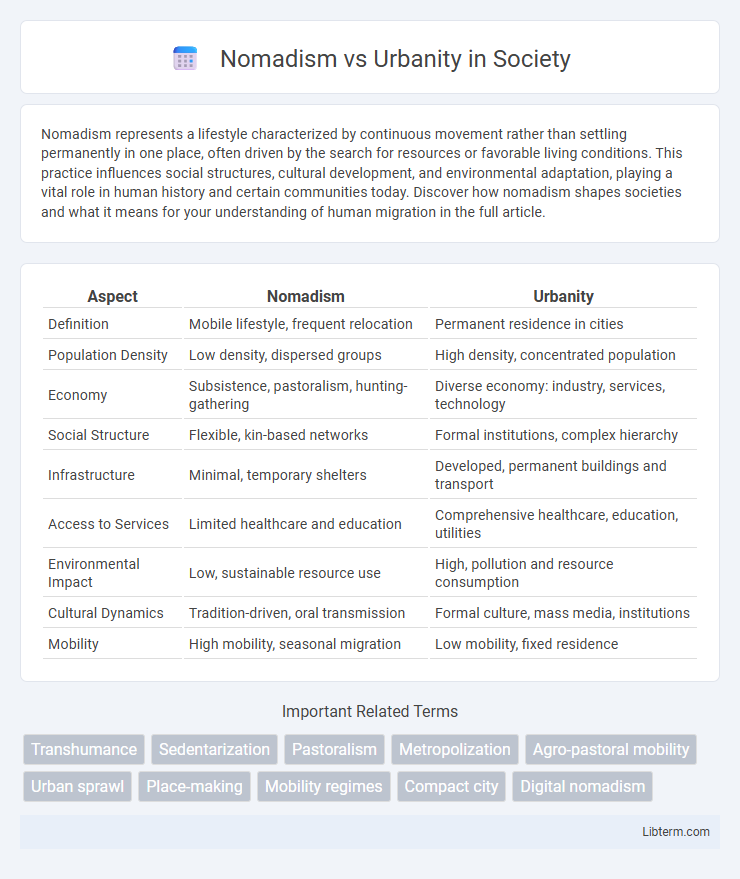Nomadism represents a lifestyle characterized by continuous movement rather than settling permanently in one place, often driven by the search for resources or favorable living conditions. This practice influences social structures, cultural development, and environmental adaptation, playing a vital role in human history and certain communities today. Discover how nomadism shapes societies and what it means for your understanding of human migration in the full article.
Table of Comparison
| Aspect | Nomadism | Urbanity |
|---|---|---|
| Definition | Mobile lifestyle, frequent relocation | Permanent residence in cities |
| Population Density | Low density, dispersed groups | High density, concentrated population |
| Economy | Subsistence, pastoralism, hunting-gathering | Diverse economy: industry, services, technology |
| Social Structure | Flexible, kin-based networks | Formal institutions, complex hierarchy |
| Infrastructure | Minimal, temporary shelters | Developed, permanent buildings and transport |
| Access to Services | Limited healthcare and education | Comprehensive healthcare, education, utilities |
| Environmental Impact | Low, sustainable resource use | High, pollution and resource consumption |
| Cultural Dynamics | Tradition-driven, oral transmission | Formal culture, mass media, institutions |
| Mobility | High mobility, seasonal migration | Low mobility, fixed residence |
Defining Nomadism and Urbanity
Nomadism is characterized by a lifestyle involving continuous or seasonal movement from one place to another, often driven by the search for resources, grazing lands, or favorable climates, predominantly observed in pastoralist and hunter-gatherer societies. Urbanity refers to the quality of life, social behavior, and cultural norms associated with living in densely populated urban areas, marked by permanent settlements, complex infrastructure, and diverse economic activities. The contrast between nomadism and urbanity highlights differing human adaptations to environment, resource availability, and social organization.
Historical Evolution of Human Settlements
The historical evolution of human settlements reveals a transition from nomadism, characterized by mobile hunter-gatherer groups, to urbanity marked by the establishment of permanent, densely populated cities like Uruk and Mohenjo-Daro around 4000-3000 BCE. This shift was driven by advancements in agriculture, surplus food production, and social stratification, enabling complex infrastructures and institutions. Urban centers became hubs of trade, governance, and cultural development, contrasting with the fluid, adaptable lifestyle of nomadic societies.
Cultural Perspectives on Mobility
Nomadism embodies a cultural paradigm emphasizing mobility as a mode of life, deeply rooted in traditions where social structures and identity evolve through constant movement. Urbanity represents sedentary cultural models where mobility is often functional, connected to economic opportunity and social engagement within fixed infrastructures. The cultural perspectives on mobility highlight nomadism's fluid social networks and adaptability contrasted with urbanity's emphasis on stability, community institutions, and spatial permanence.
Economic Implications: Nomads Versus Urbanites
Nomadism fosters a flexible economic model centered on resource mobility and adaptability, often relying on seasonal trade, livestock herding, and artisanal crafts, which supports localized consumption and minimal infrastructure investment. Urbanity drives complex economies based on industrial production, services, and technology sectors, enabling higher productivity, increased job specialization, and extensive market integration. The economic implications reveal a contrast where nomadic systems prioritize sustainability and resilience in fluctuating environments, while urban economies benefit from economies of scale, innovation, and capital accumulation.
Environmental Impact of Each Lifestyle
Nomadism typically results in a lower environmental impact due to its minimal resource consumption, as nomads rely on natural habitats and renewable resources while maintaining small ecological footprints. Urbanity, in contrast, often leads to higher levels of pollution, waste production, and energy consumption, driven by dense populations and extensive infrastructure demands. Sustainable urban planning and green technologies are essential to mitigate the environmental challenges posed by city living.
Social Structures and Community Bonds
Nomadism fosters tightly-knit, fluid social structures defined by kinship and mutual aid, emphasizing adaptability and shared responsibilities within small groups. Urbanity promotes complex, diverse social networks with formal institutions, enabling broader community bonds through cultural, economic, and institutional interactions. The contrast highlights how nomadic communities prioritize direct, personal connections, while urban societies emphasize organized, large-scale social integration.
Adapting to Technological Advancements
Nomadism and urbanity present contrasting approaches to adapting to technological advancements, with nomads leveraging portable and decentralized technologies like satellite internet and mobile power solutions to maintain connectivity on the move. Urban dwellers benefit from dense infrastructure, utilizing smart city innovations such as IoT networks, 5G connectivity, and automated public services to enhance efficiency and convenience. Both lifestyles increasingly integrate digital tools but prioritize different technological ecosystems based on mobility versus stability.
Health and Wellbeing Considerations
Nomadism often promotes physical health through increased mobility and exposure to diverse natural environments, enhancing mental well-being by reducing stress and fostering a sense of freedom. Urbanity offers advanced healthcare access, social connectivity, and wellness amenities but can also introduce challenges like pollution, noise, and sedentary lifestyles that negatively impact health. Balancing these factors is critical to optimizing overall wellbeing in both nomadic and urban settings.
Challenges and Opportunities in Modern Times
Nomadism faces challenges such as limited access to consistent healthcare, education, and stable income due to its mobile lifestyle, while urbanity contends with overcrowding, pollution, and social inequality. Opportunities for nomadic communities include leveraging digital connectivity and remote work to sustain livelihoods without fixed residences, whereas urban areas benefit from diverse economic activities, advanced infrastructure, and innovation hubs fostering growth. Both lifestyles require adaptive strategies to balance mobility and stability, ensuring cultural preservation alongside economic integration in a rapidly changing world.
The Future of Nomadism and Urban Living
The future of nomadism is shaped by increasing digital connectivity and remote work opportunities, allowing individuals to live flexibly across diverse geographic locations. Urban living evolves with smart city technologies enhancing sustainability, transportation, and infrastructure to accommodate growing populations. Hybrid models blending nomadic lifestyles with urban conveniences emerge as a transformative trend in modern living.
Nomadism Infographic

 libterm.com
libterm.com